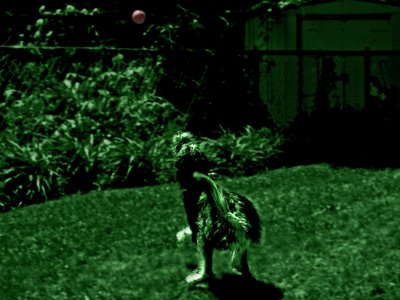How Does Pappy Chase Balls at Night?
Pappy is always standing at the sliding door to the back yard, pining to go outside and chase a ball after dinner. Now, in the heart of the Fall, this takes place in total darkness. When we first tried this I was sure that he'd lose the ball immediately, followed by him searching frantically with his tail whisking in circles and the occasional whine. Then, I envisioned, we'd be done until we found the ball the next morning.
But this isn't what happened. He was retreiving balls in the pitch black. He was snatching a ball out of mid-air, when I couldn't even find it after he dropped it at my feet. So I asked myself how he did that. A dog's bionic hearing is great, but it isn't radar. Hearing a ball's bounce is helpful, but won't tell you its trajectory and he was catching them on the fly. Smell is great for finding stationary balls, but there's some latency in scent that isn't going be as helpful in chasing them in motion.
So it had to be something to do with sight. But how can a dog who can't see the treat on the floor in front of him see a ball at night? Once, on a walk, he nearly desocketed my arm chasing after a pipe sticking out of the ground that stood a little too much like a squirrel. I looked up a couple of articles on dog sight here and here. Though dogs don't just see in black and white, their vision is only dichromatic (blue/yellow) and they don't distinguish many colors well. Apparently their visual acuity also isn't great-- if a human's vision is 20/20, a typical dog may only see from 20 feet what the person sees from 75 feet. But dogs have great night vision. First off, they have a much higher ratio of rods to cones than humans-- these are the high-definition, motion sensitive, black and white receptors in the retina. Humans have greater concentrations of rods in the peripheral vision, sometimes making it easier to see things at night by not looking directly at them. Dogs also have a "tapitum lucidum," a reflective layer behind the photoreceptors. This is what gives them the creepy glowing eyes at night. With the extra reflective layer, somehow the wavelength of dim light is enhanced providing better contrast.
Bottom line... looks like I am going out after dinner to toss balls all winter long.






No comments:
Post a Comment